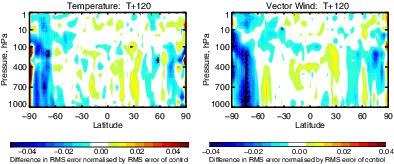当前位置:
X-MOL 学术
›
Q. J. R. Meteorol. Soc.
›
论文详情
Our official English website, www.x-mol.net, welcomes your feedback! (Note: you will need to create a separate account there.)
Direct 4D‐Var assimilation of space‐borne cloud radar and lidar observations. Part II: Impact on analysis and subsequent forecast
Quarterly Journal of the Royal Meteorological Society ( IF 8.9 ) Pub Date : 2020-07-20 , DOI: 10.1002/qj.3879 M. Janiskova 1 , M. D. Fielding 1
Quarterly Journal of the Royal Meteorological Society ( IF 8.9 ) Pub Date : 2020-07-20 , DOI: 10.1002/qj.3879 M. Janiskova 1 , M. D. Fielding 1
Affiliation

|
Observations related to cloud, such as radiances from microwave imagers, have been at the forefront of recent developments in data assimilation for numerical weather prediction (NWP). While they offer unrivalled spatial coverage, they contain limited information on the vertical structure of clouds. In contrast, active observations from profiling instruments such as cloud radar and lidar contain a wealth of information on the structure of clouds and precipitation, providing the much‐needed vertical context of clouds, but have never been assimilated directly in global NWP models. To explore the potential benefits of these profiling observations, the European Centre for Medium‐Range Weather Forecasts (ECMWF) Four‐Dimensional Variational (4D‐Var) data assimilation system has been recently adapted to allow direct assimilation of cloud profile observations from space‐borne radar and lidar instruments. In this paper, in conjunction with its companion paper, the first‐time direct assimilation of cloud radar and lidar observations into a global NWP model is demonstrated. Using CloudSat radar reflectivity and CALIPSO attenuated backscatter shows that the assimilation brings the analysis closer to these observations and has a mainly neutral affect on other assimilated observations. Some improvements in the forecast skill are also observed when verified against the experiment's own analysis, with the largest positive impact noticed for temperature at the lowest model levels and for vector wind above 500 hPa, but longer experiments are required to reach 95% statistical significance of the results. The potential improvements in the model radiation budget is explored by verifying with Clouds and the Earth's Radiation Energy System (CERES) observations. Sensitivity of the results to observation error and to the observation reduction by increased averaging is also discussed. The demonstration of statistically significant improvements to forecast skill in some metrics without any significant degredation in others shows great promise for the future use of cloud radar and lidar observations in NWP.
中文翻译:

星载云雷达和激光雷达观测的直接4D-Var同化。第二部分:对分析和后续预测的影响
与云有关的观测,例如微波成像仪的辐射,一直处于数值天气预报(NWP)数据同化的最新发展的最前沿。尽管它们提供了无与伦比的空间覆盖率,但它们包含有关云的垂直结构的有限信息。相比之下,来自云雷达和激光雷达等轮廓分析仪器的活跃观测包含大量有关云结构和降水的信息,提供了急需的云垂直环境,但从未在全球NWP模型中直接吸收。为了探索这些剖析观察的潜在好处,欧洲中距离天气预报中心(ECMWF)的四维变化(4D-Var)数据同化系统最近进行了调整,可以直接同化来自星载雷达和激光雷达仪器的云剖面观测结果。在本文中,结合其配套论文,展示了首次将云雷达和激光雷达观测资料直接同化为全球NWP模型。使用CloudSat雷达反射率和CALIPSO衰减的反向散射表明,同化使分析更接近于这些观测值,并且对其他同化观测值具有主要中性影响。通过实验本身的分析进行验证后,还可以观察到预测技能的一些改进,在最低的模型水平和500 hPa以上的矢量风中,对温度的影响最大,但是要达到95%的统计显着性需要更长的实验。通过用云和地球辐射能系统(CERES)观测值进行验证,探索了模型辐射预算的潜在改进。还讨论了结果对观察误差的敏感性以及通过增加平均对观察减少的敏感性。在某些指标上对预报技能进行统计学上显着改进的演示,而在另一些指标上却没有任何明显的下降,这表明了未来在NWP中使用云雷达和激光雷达观测的巨大希望。通过用云和地球辐射能系统(CERES)观测值进行验证,探索了模型辐射预算的潜在改进。还讨论了结果对观察误差的敏感性以及通过增加平均对观察减少的敏感性。在某些指标上对预报技能进行统计学上显着改进的演示,而在另一些指标上却没有任何明显的下降,这表明了未来在NWP中使用云雷达和激光雷达观测的巨大希望。通过用云和地球辐射能系统(CERES)观测值进行验证,探索了模型辐射预算的潜在改进。还讨论了结果对观察误差的敏感性以及通过增加平均对观察减少的敏感性。在某些指标上对预报技能进行统计学上显着改进的演示,而在另一些指标上却没有任何明显的下降,这表明了未来在NWP中使用云雷达和激光雷达观测的巨大希望。
更新日期:2020-07-20
中文翻译:

星载云雷达和激光雷达观测的直接4D-Var同化。第二部分:对分析和后续预测的影响
与云有关的观测,例如微波成像仪的辐射,一直处于数值天气预报(NWP)数据同化的最新发展的最前沿。尽管它们提供了无与伦比的空间覆盖率,但它们包含有关云的垂直结构的有限信息。相比之下,来自云雷达和激光雷达等轮廓分析仪器的活跃观测包含大量有关云结构和降水的信息,提供了急需的云垂直环境,但从未在全球NWP模型中直接吸收。为了探索这些剖析观察的潜在好处,欧洲中距离天气预报中心(ECMWF)的四维变化(4D-Var)数据同化系统最近进行了调整,可以直接同化来自星载雷达和激光雷达仪器的云剖面观测结果。在本文中,结合其配套论文,展示了首次将云雷达和激光雷达观测资料直接同化为全球NWP模型。使用CloudSat雷达反射率和CALIPSO衰减的反向散射表明,同化使分析更接近于这些观测值,并且对其他同化观测值具有主要中性影响。通过实验本身的分析进行验证后,还可以观察到预测技能的一些改进,在最低的模型水平和500 hPa以上的矢量风中,对温度的影响最大,但是要达到95%的统计显着性需要更长的实验。通过用云和地球辐射能系统(CERES)观测值进行验证,探索了模型辐射预算的潜在改进。还讨论了结果对观察误差的敏感性以及通过增加平均对观察减少的敏感性。在某些指标上对预报技能进行统计学上显着改进的演示,而在另一些指标上却没有任何明显的下降,这表明了未来在NWP中使用云雷达和激光雷达观测的巨大希望。通过用云和地球辐射能系统(CERES)观测值进行验证,探索了模型辐射预算的潜在改进。还讨论了结果对观察误差的敏感性以及通过增加平均对观察减少的敏感性。在某些指标上对预报技能进行统计学上显着改进的演示,而在另一些指标上却没有任何明显的下降,这表明了未来在NWP中使用云雷达和激光雷达观测的巨大希望。通过用云和地球辐射能系统(CERES)观测值进行验证,探索了模型辐射预算的潜在改进。还讨论了结果对观察误差的敏感性以及通过增加平均对观察减少的敏感性。在某些指标上对预报技能进行统计学上显着改进的演示,而在另一些指标上却没有任何明显的下降,这表明了未来在NWP中使用云雷达和激光雷达观测的巨大希望。



























 京公网安备 11010802027423号
京公网安备 11010802027423号